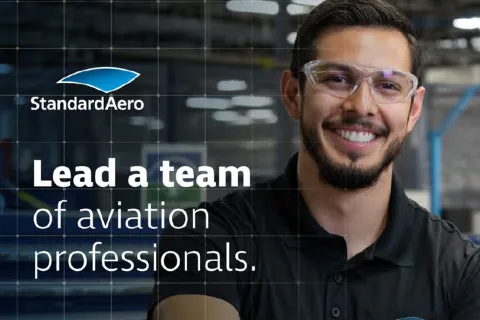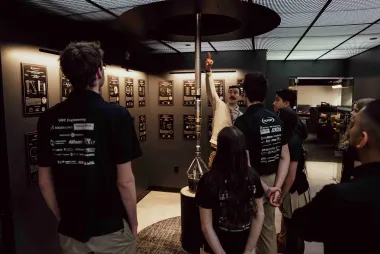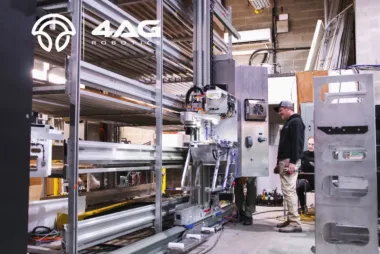This spotlight features StandardAero, a global company with local operations in Richmond and Langley that provides maintenance, repair, and overhaul services and solutions for the aviation sector. We spoke with Nok Limchareon, Human Resources leader, about the company and its culture. Daniel Luk, Senior manager of Engineering, and Jacky Cheng, Director of Engineering, also shared their advice for students interested in working at the company.

What does StandardAero do?
StandardAero is one of the World’s leading independent providers of aerospace engine Maintenance, Repair, Overhaul (MRO) services for fixed and rotary-wing aircraft, serving the commercial, military and business aviation end-markets. StandardAero provides a comprehensive suite of critical, value-added aftermarket solutions, including engine and engine component MRO, on‑wing and field service support, aviation asset management, and engineering solutions.
StandardAero achieved annual revenues exceeding $5.2 billion (USD) in 2024 and employs nearly 8,000 professional, administrative, and technical employees working in over 50 operating locations in 12 countries including strategically located repair shops and regional service and support centers all across the globe. The company is authorized and licensed to provide services to engines and aircraft from world leading Original Equipment Manufacturers (OEM). StandardAero is an NYSE listed company trading under the ticker symbol SARO.
What is the culture like, and how do you support the professional growth of your employees and co-op students?
The MRO business is highly specialized and competitive, and workforce management is critical to our success. We are focused on a friendly, receptive, and transparent culture and creating an environment where employees can thrive. Our approach allows us to retain top professionals who share our dedication to quality and innovation.
- Early Career Partnerships: We believe that building a strong talent pipeline starts with meaningful, long-term partnerships. Through our early career initiatives, we don’t just recruit the best talent—we invest in students by offering valuable career development opportunities. From interactive info sessions and class visits to hands-on training and resume reviews, we are focused on equipping the next generation with the skills and insights they need to succeed in the aviation MRO industry. By fostering these connections early, we create a steady flow of top-tier talent while giving back to the communities that shape the future of our workforce. We prioritize skills training so that our team remains at the forefront of industry advancements and regulatory standards. Through comprehensive learning development plans and hands-on technical training and classroom-style learning opportunities, we equip our employees with the expertise they need to deliver exceptional results and remain at the forefront of industry advancements and regulatory standards.
- Leadership Development: We offer our employees opportunities to learn new skills and advance in their careers to become leaders who can inspire and motivate teams to effectively communicate and execute company strategies. We invest in leadership development programs because they improve employee engagement and productivity and drive better business outcomes all-around.
What qualities or skills do you look for when hiring a co-op student?
We are looking for students that are detail-oriented team players who work well with our engineers and technicians, are passionate about aviation, and excited to work as part of a multidisciplinary engineering team. The designs we produce span everything from mechanical components to electrical systems and aircraft certification. Because of this, it's important for students to be adaptable, collaborative, and have strong communication skills. Students who have participated in extracurricular engineering teams—such as AeroDesign or SAE Formula—often bring valuable hands-on experience working across disciplines, which translates well into our environment.
How do UBC co-op students contribute to your organization?
We like students who are eager to learn and grow in the aviation industries. Some may provide suggestions or ask questions that help challenge and improve our processes. We’ve had great success with co-op students making meaningful contributions to our projects. They’ve been involved in developing new designs for Supplemental Type Certificate (STC) modifications on helicopters, including contributions to our stable light autopilot STC and various aircraft completion projects for different operators. Co-op students have also supported our manufacturing teams by helping industrialize products and improve process efficiency and quality. Our project needs vary, and co-op students often work alongside senior engineers across a range of technical tasks.
What advice do you have for students interested in working at StandardAero?
Daniel Luk, P.Eng, Manager, Engineering Sr. who is based at the Richmond location said: Students help us out a lot on various tooling verification and design projects, preparing technical instructions or guidelines for technique sheets, and helping out with technical reports.
Jacky Cheng, P.Eng., Director, Engineering from the Langley location said: I encourage all aspiring engineers to take on challenging projects outside of regular coursework. Joining student engineering teams pushes your limits and offers valuable lessons—especially when things don’t go as planned. Learning from failure is just as important as celebrating success, and both help you grow as an engineer. Build a portfolio of your projects that you can share with potential employers. Engineers love to “geek out” over innovative ideas and are always excited to learn from fresh perspectives.


